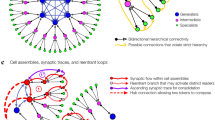Abstract
The way in which artificial intelligence has developed over the last 50 years has had a major role in shaping cognitive science as it is today. This has generated computational models of behaviour. The connectionist revival of the 1980s added a tinge of neurodynamics to this. Here I suggest that some post-connectionist work in artificial intelligence is turning towards an understanding and formalisation of the mechanisms of brain architectures which contribute to an emergence of cognition providing a closer link between brain mechanisms and experienced brain states. This even addresses the neurological basis of consciousness.



Similar content being viewed by others
References
Aleksander I (1996) Impossible minds: my neurons, my consciousness. Imperial College Press, London
Aleksander I (2001) How to build a mind: machines with imagination. Columbia University Press, New York
Aleksander I, Dunmall B (2000) An extention to the hypothesis of the asynchrony of visual consciousness. Proc R Soc Lond B 267:197–200
Aleksander I, Dunmall B (2002) Axioms and tests for the presence of consciousness in agents. J Consc Stud 10(4–5)
Boden M (1977) Artificial intelligence and natural man. Harvester Press, Hassocks
Bressloff PC, Cowan JD, Golubitsky M (2002) What geometric visual hallucinations tell us about the visual cortex. Neural Comp 14:473–491
Crick F, Koch C (1992) The problem of consciousness. Sci Am 267(3):110–117
Dehaene S, Changeux JP (1997) A hierarchical neuronal network for planning behavior. P Natl Acad Sci USA 94:13293–13298
Fukushima K (1988) Neocognitron: a hierarchical neural network capable of visual pattern recognition. Neural Netw 1:119–130
Gardner H (1985) The mind’s new science. Basic Books, New York
Grossberg S (1988) Nonlinear neural networks—principles, mechanisms and architectures. Neural Netw 1:17–61
Harley TA (1995) The psychology of language: from data to theory. Taylor and Francis, London
Hinton GE, Sejnowski T (1986) Learning and relearning in Boltzmann machines. In: Rumelhart DE, McClelland JL (eds) Parallel distributed processing. MIT Press, Bradford Books, Cambridge, Massachusetts, pp 282–387
Hopfield JJ (1982) Neural networks and physical systems with emergent collective properties. Proc Nat Acad Sci USA 79:2554–2558
Humphreys GW, Bruce V (1989) Visual cognition: computational, experimental and neuropsychological perspectives. Lawrence Erlbaum Associates, London
Kohonen T (1988) Self organisation and associative memory, 2nd edn. Springer, Berlin Heidelberg New York
Kosslyn SM (1996) Image and brain: the resolution of the imagery debate. MIT Press, Bradford Books, Cambridge, Mass.
Marr D (1982) Vision. Freeman, San Francisco
Rumelhart DE, McClelland JL (1986) Parallel distributed processing. MIT Press, Bradford Books, Cambridge, Massachusetts
Shannon CE (1950) Programming a computer for playing chess. Phil Mag 41(7):256–275
Zeki S (1993) A vision of the brain. Blackwell Science, Oxford
Acknowledgements
The author is grateful to the Wellcome Trust for having provided a Showcase award to study ‘What’s it like to have a mental deficit?’ and to the Leverhulme Trust for funding work on ‘Depiction in Vision and Language’.
Author information
Authors and Affiliations
Corresponding author
Rights and permissions
About this article
Cite this article
Aleksander, I. Emergence from brain architectures: a new cognitive science?. Cogn Process 5, 10–14 (2004). https://doi.org/10.1007/s10339-003-0001-z
Received:
Accepted:
Published:
Issue Date:
DOI: https://doi.org/10.1007/s10339-003-0001-z




